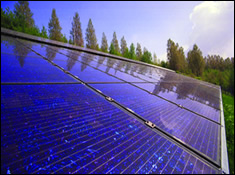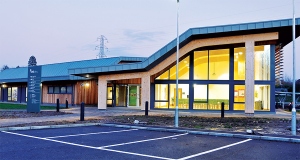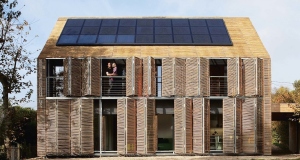- Renewable Energy
- Posted
The Potential of Renewable Energy

The German-Irish Chamber of Industry and Commerce (GICIC) has just completed a study titled “The Potential of Renewable Energy in Ireland”.
Based on the study’s findings, Bernd Reinhard, Deputy Executive Director of the GICIC outlines the potential that fast emerging renewable technologies possess to revolutionise Ireland’s energy supply, from wind power’s capacity on a national level, to the benefits the likes of solar and geothermal can offer proactive homeowners
The analysis of this study focuses on the potential of alternative energy sources in Ireland. Additionally, it looks at incentives and the legal framework. The paper is only one part of a GICIC campaign to promote the take-up of renewable energy in Ireland. According to Ralf Lissek, Executive Director of the German-Irish Chamber of Industry and Commerce, the study provides an “excellent basis for decision makers as well as private investors”. It shows that there is huge potential for the use of renewable energy in Ireland and also identifies which technologies should be regarded as priorities in relation to implementation and funding. For example, up to now initiatives to promote renewable energy have neglected the heat market.
Renewable energy sources cannot be regarded as substitutes for fossil fuels in the short term. Nevertheless, they provide a superior alternative for the future and it is essential to start using them now in order to gain the necessary experience. Wind and the sun are sources of energy which do not produce carbon dioxide. Certain other sources of renewable energy, such as biomass, have to be combusted to produce energy. In contrast to the combustion of fossil fuels, the combustion of biomass is carbon dioxide neutral. Renewable energy sources are in the main cost-free commodities to which everyone has unlimited access. Enhancing their use also helps to reduce the dependency on costly energy imports.
On one hand, Ireland has successfully implemented wind farming and the use of hydropower. On the other hand bearing in mind her international commitments in relation to the environment, Ireland still needs to catch up in other fields of renewable energy. Ireland benefits from the most favourable climate conditions, and failure to reap the benefits of the huge potential that exists by using the readily available technology would constitute a burden for the next generation. To date Ireland has not tapped into the potential in the heat market at all, particularly for housing.
There is enormous potential for the use of renewable energy sources in Ireland. The German-Irish Chamber has calculated the technical potential – the potential at the current technical level – of the whole range of renewable energy sources to be more than 728,000 GWh per annum. That is more than four times the current total Irish energy requirement (175.000 GWh per annum). However, the technical potential differs from the economic potential – which is to be defined as the economically viable part of the technical potential, taking all costs and additional financial benefits into account.
The central question is why the economic potential is lower than the technical potential. In essence, the unfavourable environment for renewables allied to the absence of incentives, is hampering the enhanced use of renewable energy. Renewable energy is made almost unviable, because energy production from fossil fuels is still cheaper than tapping into renewable energy sources. In addition, the unfavourable framework conditions including the regulatory environment and the lack of public awareness and know how continue to impede further deployment.
The external costs of fossil fuels, such as environmental pollution, greenhouse effect, decreasing energy sources for generations to come, and so on, are not being taken into consideration in the pricing process for fossil fuels. The development and implementation of political strategies for the internalisation of those external costs are necessary. In the current discussion, the carbon dioxide tax and emission trading seem appropriate. This will highlight the comparative cost benefits of renewable energy and prepare the market for the application of these technologies.
There is also a lack of public awareness of the applications and potential uses of renewable energy sources, both overall and individually, and of the benefits to be gained. Often, both consumers and the public sector baulk at higher initial investment involved. Neither takes into consideration the long-term benefits, such as lower operational costs, environmental advantages, and so on. In addition, funding problems occur in both the public and private sectors. Large-scale projects are only viable if granted power purchase agreements within the framework of the AER-Programme.
Both politicians and decision-makers in public administration, and representatives of the energy sector, often suffer from lack of experience and specialist knowledge when making decisions regarding renewable energy. This leads to flawed judgements in relation to project proposals and to the implementation of unfavourable planning guidelines in the construction sector. Furthermore, engineers, architects and planners as well as installation and maintenance companies lack the necessary experience – if not the technical knowledge.
Finally, the infrastructure in place for energy supply tends to be centralised, which impedes distributed smaller applications. The main problems encountered are the condition of the grid and an unfavourable legal framework, in addition to complicated contract and approval procedures for the construction and operation of power plants.
According to Ralf Lissek, Executive Director of the German-Irish Chamber of Industry and Commerce, there are “numerous government subsidies available for electricity generation or for research, development and demonstration purposes. Nevertheless, we wonder why there are no funds available for heat generation from renewable sources in private households.” He also points out that only the private sector – if funded for the use of renewables will generate the necessary demand to convince installers to deal with the matter. “Public projects are financed by the exchequer. We hear that these projects are assessed only in relation to the amount of the initial investment costs with no consideration being taken of the recurring expenses. It takes a number of years for renewable energy technologies to pay off. With this framework in place, what hope can there be for renewable energy technologies to be used in public building projects?”

In relation to hydropower, the potential has almost been utilised to its full extent. Some of the existing hydro power plants could do with an upgrade but that is about it.
Wind power systems are currently very popular in Ireland. The potential offered by wind power systems is by far the biggest among renewable sources in Ireland but will not be met in the next few years. Off shore technology in particular will play a major role in Ireland’s energy future. A substantial increase in wind power fed into the grid will make adjustments in grid management necessary.
There is also huge potential in the area of Photovoltaic (PV) systems. However, their contribution to electricity production will hardly be significant in the next few years as this technology is by far the most expensive of all electricity producing renewables. Nevertheless, PV already has a certain amount of potential in remote geographical areas without grid access and in niche markets such as disc machines.
Alongside wind, biomass shows the highest potential of all renewables in Ireland. However, biomass systems are uncommon in Ireland at present. One possible reason for this might be that people are not really aware of the variety of materials defined as suitable for use in biomass combustion or of the range of technologies available for energy production from biomass. Specially grown energy crops could make as substantial a contribution as wood waste, grass, straw and so on. Either domestic applications for heating purposes or large-scale power plants for heat and electricity production are possible.
There is also a high level of potential in the area of biogas produced from anaerobic digestion. Biogas plants will digest manure, slurry and chicken litter as well as energy crops including rapeseed, corn, and urban biodegradable waste. The combustion of the harvested biogas in a CHP will produce electricity and heat, which can be used for municipal heating for instance. A breakthrough for this technology in Ireland is more likely to materialise within the field of waste management than in the agricultural sector.
Another source of vast potential is available from solar thermal applications for mostly residential use. Solar thermal systems are able to cater for the hot water needs of households and with larger applications for heating purposes. By combining this with the opportunities offered by passive solar schemes, investors can considerably reduce their heating bills.
There is massive potential for heat pumps thanks in no small measure to the very advantageous Irish climate. Heat pumps, where used in Germany or Switzerland, have to cope with temperature differences of 40 – 60 degrees, whereas in Ireland, it is hardly 30 degrees. Therefore, if they work in Germany and pay off during their lifetime, they will work even better in Ireland.
From our point of view, the Irish government should take a completely new approach, funding renewable energy from the beginning by providing low level financial incentives for small-scale projects (involving solar collector systems, heat pumps, biomass boilers, and PV-systems). The programme should be designed for a minimum period of 8 years. Subsidies should be given in accordance to the installed system size. Subsidy levels should be reduced throughout the lifespan of the programme to force manufacturers and distributors to reduce their system prices.
Medium sized projects like CHP-plants for renewable energy sources like biomass and biogas plants should be given low or interest-free loans. Large scale projects like wind farms could be funded by low interest loans as well.
For both medium and large scale projects that produce electricity, grid access should be granted generally and a scheme of feed in tariffs should be determined.
Unlike wind power, distributed generation especially from biomass and biogas CHPs can deliver a constant flow of electricity without back-up systems. This can make new power plants obsolete and largely contribute to cost saving once the necessary grid management is put in place.
The Irish government is currently reviewing its renewable energy policy. It now has the chance to allocate the necessary budget to the development of the renewable energy market. The necessary funds could be sourced from the revenue created from the carbon-dioxide tax and emission trading.
The GICIC offers seminars, workshops and presentations free-of-charge. “We address architects, engineers, farmers, lecturers, local authorities, professionals, students and many more in order to create public awareness”, says Mr Ralf Lissek, Managing Director of the GICIC. The campaign also considers occupations that require further training, such as electricians, plumbers and roofers, too. Provided with this knowledge, the occupations involved will be able to install the technologies that architects and engineers will be designing in the future. Moreover, qualified installers will encourage investor confidence in renewable technologies.
This will also support the development of the Irish market for renewables. Currently, Irish manufacturers of renewable energy systems are practically nonexistent. This hampers consumer confidence in renewable technologies.
Therefore, the GICIC organises trade missions for German manufacturers to fill this gap. They have developed innovative and affordable high-tech products, and the first meetings between Irish and German companies have been very successful.



